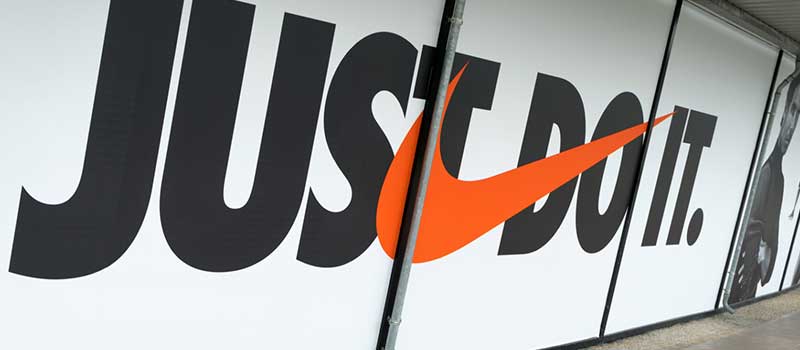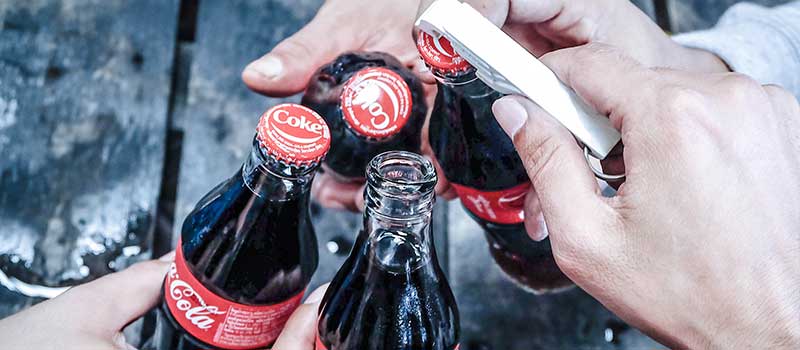People prefer not to hand over their hard-earned money to cold, overly corporate businesses.
Instead, we like to feel like we’re purchasing from businesses with a personality.
A corporate branding strategy is essentially a plan for personalizing your business and customizing every touchpoint for consumers so that it exudes personality through your brand identity and brand image.
Think about when you walk into an Apple Store.
Everything about the place screams Apple.
Even if there were no products or brand logos, you’d still know you were in an Apple store.
This recognition is not an accident but the result of carefully crafted corporate branding.
Let’s drill down and define the concept.
What Is Corporate Branding?

Corporate branding means promoting your brand name and all-encompassing concept as a business to your target audience.
It’s a careful definition and execution of how you present the corporate entity to the customer.
Therefore, a company’s brand usually reflects its values and position through its image, identity, and brand messaging across all marketing materials.
The objective is to communicate the essence and spirit of your company, building its reputation while cementing your place in the industry and in the minds of consumers.
Brand managers who do this well can give their brand a competitive edge in the market.
Corporate Branding vs. Product Branding

To explore this a little further, it’s helpful to compare corporate branding to product branding.
Product branding aims to build the product’s reputation as a brand in and of itself, without necessary reference to the corporate brand.
The iPhone is a perfect example of a product brand.
We don’t say “The Apple iPhone”, we just say “iPhone”.
On the other hand, corporate branding aims to build the reputation of the company, rather than its products.
It defines the overarching position of the brand in the market and what the brand believes as an entity.
PRO Brand Strategy BluePrint
Build Brands Like A Pro Brand Strategist

How Corporate Branding Supports Employee Branding

Another key difference is the audience.
Product branding is directed at the consumer and the consumer only.
While we’ve already established that the corporate brand needs to be communicated to customers, they’re actually not the only stakeholders.
Increasingly, your corporate identity and brand image must run right through your organization with employee appeal and buy-in.
If employees believe what the brand believes, they’re more likely to want to be part of the brand and also more likely to produce their best work.
Therefore, your marketing strategy must also have an internal aspect, communicating and embedding the brand into the company culture.
After all, employees are the brand advocates for your business.
It’s not rocket science.
Employees who don‘t believe in the company’s mission are not likely to be great advocates.
There is, of course, a link between corporate branding and product branding.
Like a parent, the corporate brand is the overarching guide of the product brand.
Explore Brand Strategy
Programs & Tools
Why Corporate Branding Is So Important

Quite simply, corporate branding efforts shape the perception of a business for all stakeholders.
Successful corporate branding, therefore, must be consistent across all touchpoints, and this goes way beyond familiarity with the logo.
Let’s return to that idea of the Apple store.
Apple has a distinct visual identity and brand experience that is consistent worldwide, whether you’re in New York, London, Paris, Tokyo, or Sydney.
The sleek, clutter-free, modern design of its stores represents the sophisticated simplicity of its products.
In other words, the products and the stores they’re sold in are elegantly aligned.

There are plenty of helpful staff on hand to help you, reemphasizing the company’s customer-centric approach.
They’re technologically savvy as they demonstrate new product features, reinforcing the idea that these products are innovative.
But, they’re dressed casually, they’re easy to speak to and they’re relatable.
None of this is a coincidence.
Everything you see and experience is influenced by the brand strategy set out in the brand guidelines.
This expert example of corporate branding is an excellent answer to the question, “Why is corporate branding important?”.
Apple manages to communicate its unique value proposition through everything it does.
How To Build A Strong Corporate Brand

Developing a strong brand is not an overnight job.
The brand strategy defines “who” the company is as a brand, defining everything from the values, vision, personality, and, of course, the position.
Let’s follow some guidelines and steps to creating a strong corporate brand.
#1. Define What’s Inside

This section is about defining your purpose, vision, mission, and values
Understanding who you are as a company, the direction you’re heading in, and what you stand for will help inform your messaging.
Come up with succinct definitions and statements related to:
the value proposition
the mission statement and purpose
the short-term and long-term goals – the vision
Having a firm understanding of these aspects of the company help inform the brand manager’s activity and will directly impact the nature of all Marketing collateral.
Your marketing strategies will be more accurate and targeted the more specific you can be about your company values.
Create a foundational document outlining these aspects and think of it as a branding blueprint that should inform all further decision-making.
#2. Uncover Who You’re For

This is about uncovering your target audience.
After an introspective session, you’ll need to look outwards.
Who is your brand for?
Whose problems are you solving?
Who is the target audience that your brand is aimed at?
A successful brand needs to have a clear, well-defined target audience so you can tailor your marketing strategies to appeal to them.
Don’t try to put the cart before the horse; you can’t possibly hope to connect with your audience without a thorough understanding of their likes and dislikes.
Conduct market research to understand the way your audience consumes content and the values they possess.
Also, try to get to grips with their specific pain points so you know how to frame your company as a solution provider.
#3. Define Why You’re Different

You’ve probably heard the idea that no brand exists in a vacuum.
A brand has a position alongside its competitors in the marketplace in the mind of customers.
That means that you can’t hope to create a successful brand that appeals to your audience without first understanding the dynamics of the competitive marketplace.
You must step back and view the market from your customer’s perspective. They are buying your product or service, and they have a range of brands to choose from.
Why should they choose yours over any other?
That is a critical question – why choose you?
To answer this well, you’ll need to create a comprehensive positioning strategy to define a unique position in the market for your brand.
The objective is fairly simple. In a mixed-up muddle of competing brands, how can you make yours stand out and appeal to your target audience?
Once you have defined why your value proposition is different from any of your competitors, you can set about communicating this to your audience.
#4. Develop Your Communication Method

Branding is a hefty task with many elements to define.
However, now that you’ve established clear guidelines relating to who you are, who you’re for, and why you’re different, that should make it easier to develop your communication methods.
Developing your communication method is about defining what you’ll say and how you’ll say it from your personality attributes as a brand and how this is expressed through your verbal identity and brand voice.
More than any other element in your brand strategy, your communication framework is your most influential tool of influence.
Your tone of voice needs to resonate with your audience, communicating your identity while effectively expressing your brand’s personality.
Creating that distinctive voice allows you to build deeper, longer-lasting connections with your customers.
#5. Craft Your Experience

Your brand experience shapes the image of your brand in the mind of your audience.
So, when crafting your customer experience across all touchpoints, you must clearly define a visual identity that combines with your verbal identity for clear, consistent messaging.
These touchpoints may include websites, advertisements, social media profiles, business cards, your content marketing efforts, or a physical storefront.
Each and every one of your touchpoints represents an opportunity to show consistency and earn trust.
In short, anything the customer experiences in connection with your brand will help shape their image from your brand identity to brand values to your brand’s story and beyond.
#6. Show Up Consistently

Implement a corporate branding strategy to ensure your brand identity shows up consistently across all touchpoints.
As simple as that, right?
Okay, so what does “implement a corporate brand strategy” actually mean?
Well, it means using your defined company values to create clear branding guidelines to inform all branding activity.
Create a style guide that sets out your brand’s purpose and its verbal and visual identities, and share this with employees.
This guide will clarify your brand’s fixed philosophy with clarity to all stakeholders.
It will also outline the specifics of how and when to use logos, use of company fonts, directions for the tone of voice in marketing collateral, appropriate templates for social media posts, etc.
The contents of your style guide will naturally vary from business to business.
The purpose, though, should be clear.
The style guide enables you to invoke the brand identity through all customer touchpoints through your branding choices and provides a framework to enable all staff and employees to reinforce this.
Top Corporate Brand Examples

Nike

Nike has maintained its position at the top of the sportswear industry for decades. How has its corporate branding contributed to its success?
Nike has managed to straddle a position whereby it frames itself as the brand of choice for all athletes.
Nike is constantly improving its products with new soles for running shoes, new anti-sweat technology in its clothing, and advanced materials for better control in its football boots, all supported by high-profile celebrity endorsements.
Yet, its tagline – “Just Do It” – encourages everybody to embrace their inner athlete, suggesting we’re all sportspeople.
Nike’s co-founder once said, “If you have a body, you’re an athlete”.
This mentality is embedded into their branding, directed by their value proposition to ordinary people:
buy our stuff at reasonable prices to improve your performance as an athlete, no matter what level you’re at.
This notion of sportswear for the everyman is reinforced through its CSR activities in which the brand message is reflected through support for impoverished communities, reinforcing the idea that sport is for everyone.
Coca-Cola

Coca-cola is bad for your health. That’s a fairly uncontroversial statement.
And yet, millions of young people drink coca-cola every day, and they have done for decades.
Coca-cola is the master at harboring that meaningful connection through its branding.
After all, they just sell soft drinks, but their corporate brand is one of vitality and vigor and fresh, youthful vibrancy.
Their tagline “Taste the feeling”, indicates that they’re selling a feeling as much as a beverage.
Whether it’s the vibrant red color palette of the logo or the plethora of celebrity endorsements over the years, the brand strategists at Coca-cola have managed to continuously convince consumers to choose them over their competitors.
A large part of that is down to a well-crafted brand image developed and maintained over time.
Trader Joe’s

Trader Joe’s is a national grocery store that uses its brand to clearly differentiate itself from other stores,
At Trader Joe’s, they go to incredible lengths to foster their image as your friendly neighborhood store.
That hyper-personalized experience is shown through everything you see in-store – fun Hawaiian shirts, welcoming displays, good-quality products at reasonable prices, feel-good music played over the sound system, etc.
Through all this, they’re effectively saying to their loyal customer base, “grocery shopping doesn’t have to seem like such a chore.”
People head to Trader Joe’s because they know it’s cheaper and more welcoming than Whole Foods or Stop and Shop, and its corporate branding efforts have solidified that idea.
Over To You
A corporate branding strategy is a plan for personalizing your business and customizing every touchpoint for consumers to represent your brand identity.
This strategy is important so that you build a meaningful connection with your customer. The logic being that customers like to buy from businesses they feel they can relate to.
Corporate branding takes a wide look at your company’s values, ideals, and objectives. Product branding, on the other hand, focuses on the marketing campaign for a specific product.
To implement a corporate brand strategy, you need to define your company values, assess your current brand health, do your research, and then use all the collected information to introduce new brand guidelines.
Apple, Nike, Coca-Cola, and Trader Joe’s are examples of strong corporate brands because their brand identities are clear to customers.
On-Demand Digital Program
Brand Master Secrets
Make the transition from hired-gun to highly valued brand strategist in less than 30 days. The systems, frameworks and tools inside this comprehensive program are all you need to level up.








